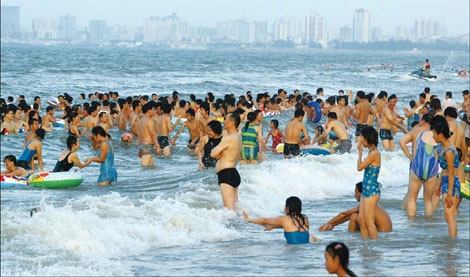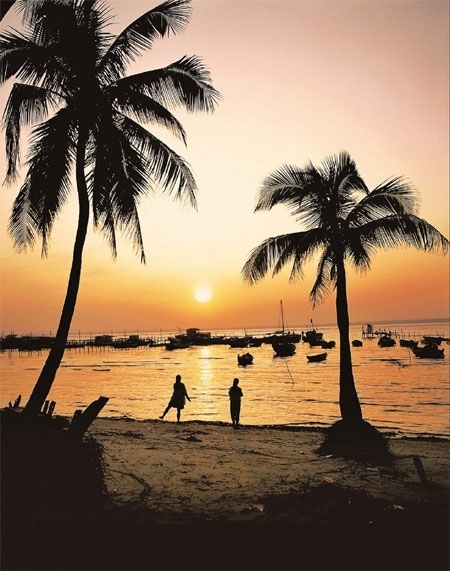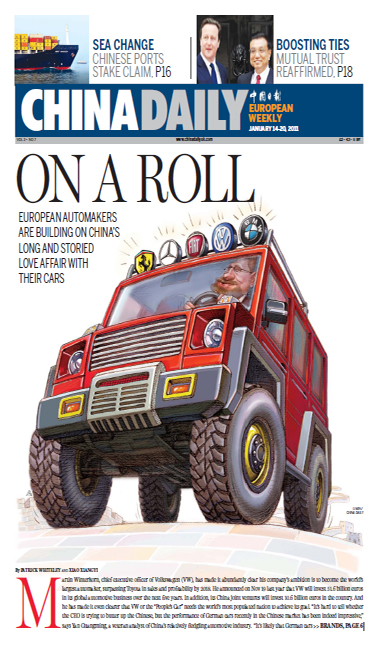Tropical dream
Updated: 2010-12-24 10:14
By Matt Hodges (China Daily European Weekly)
|
Hainan island is known for its beautiful beaches and near-perfect climatic conditions as it shares a similar latitude with Hawaii. [Photo/China Daily] |
Tourist numbers are growing every year, despite a hiccup due to the global recession.
Last year, Sanya welcomed 6.7 million tourists, including 317,833 non-Chinese. It has already matched those numbers in the first 10 months of 2010, with the number of foreign travelers up 44 percent on-year, according to statistics provided by the Sanya tourist office.
"We expect to see the numbers this year slightly edge where we were prior to the economic tsunami in 2008," says Chen Minjian, deputy director of the Sanya Tourism Industry Development Bureau.
While he packages the island as a golfing destination for Koreans and Japanese, he privately believes the plan to court Westerners may take as long as a generation.
"Europe and America are not our main markets, but we're working on them," he says.
Europeans account for only between 1 and 2 percent of all tourists to Hainan, while Russians represent more than half of non-Chinese visitors. Dadonghai seems to cater specifically to middle-aged Siberian couples and is plastered with Cyrillic signboards.
"We call it the Russian district," says Daria Shorova, a local agent for Pegas Touristik, Russia's biggest tour operator.
|
|
"Younger Russians tend to prefer to go to Thailand or Guam, but we're getting more people coming here every year," she says, adding that 60 percent of her clients come for traditional Chinese medicine therapy, and are surprised at the cost of the resorts.
"A lot of them tell us, 'I didn't bring enough money. I thought it would be cheaper'."
She said the low English literacy rates and lack of entertainment options were the biggest issue for tourists.
Among a raft of fast-tracked policy revisions to attract foreign travelers, especially those in the luxury segment, Hainan awarded 26 countries, many of them European, special visa-exemption status from Jan 1. It also loosened restrictions on foreign yacht owners in October.
Island authorities are now awaiting approval from Beijing on a proposal to turn Hainan into a duty-free zone for domestic travelers, which is expected to go into effect early next year. At present, only foreigners can pick up their duty-free goods at the airport.
Meanwhile, luxury brands like handbag-maker Louis Vuitton, Armani and Chanel are in the sights of Hainan's tourism board as it aims to court big spenders from China and abroad.
The local government admits it will take at least a decade to catch up with more mature island tourism markets in the region, but it doesn't plan on dragging its heels. Sanya staged the island's fifth Miss World contest in eight years in October, sending out the message to an estimated TV audience of 1 billion that there is a new player in the market.
Around the same time, Tiger Woods' former coach Hank Haney was teaching swim king Michael Phelps and Hollywood superstars Matthew McConaughey and Katherine Zeta-Jones how to improve their swings in the capital city of Haikou, about a four-hour drive north of Sanya.
This was a prelude to the Star Trophy competition that Mission Hills, the world's biggest golf club, launched to publicize its Haikou resort, which opened in March. The Golf Channel came, screened highlights and rhapsodized about the island's charms. The tournament was supported by Haikou authorities.
|
|
"The local government is going to all these international trade fairs to spread the word (and put Hainan on the map). We just need to go out and sell it," says the Sheraton's Ko.
"Phuket and Bali have this exotic aura, but we have better weather (as he spoke, it was snowing in Shanghai, but temperate in Sanya), and competitive pricing. All we need is international sightseeing spots. The current ones, like Big Buddha on South Mountain, have too much of a domestic orientation.
Attracting European, American and other non-Asian tourists is a part of China's opening-up policy that began 25 years ago, back when Sanya was a sleepy fishing village. In the late 1980s, former Chinese leader Deng Xiaoping established the island province as the country's largest special economic zone.
Whether it can rival mature Asian destinations in Thailand and the Philippines is open for debate. Some say Northeast Asia may be a more realistic target, lumping it in the same bracket as Korea's Jeju Island and Okinawa in Japan. Jeju saw its tourist numbers rise 12 percent when it went duty free, and Hainan is hoping for even better results.
However with its lack of infrastructure - swathes of Sanya are under construction - its Chinese culture, cowboy-like taxi drivers who rank among the worst in China and bottle-necked local airports that suffer from a paucity of direct international flights, Hainan faces more obstacles in its path than an Olympic hurdler.
"New resorts and residential properties are popping up like mushrooms, but the infrastructure is not keeping pace," says Lim.
Some complain about the frequency of traffic accidents on the roads caused by farmers and villagers not obeying traffic rules; others are waiting for Hainan to get a Walmart, Carrefour, Starbucks or international medical facilities. There is no big shopping mall yet.
Some of these problems are being addressed, but it's not going to happen overnight.
A new high-speed train that will shorten the journey between Sanya and Haikou to 90 minutes should open on a trial basis next month, while Sanya's single-runway airport will double its passenger-flow capacity from 9 million to 20 million next year, officials say.
The local government is also offering charter flights subsidies of 10,000 yuan every time they touch down in Sanya, but Chen admits that attracting more direct routes is a problem due to the lack of foreign visitors going both ways.
For long-term expats, modernization is a double-edged sword that has left the city's narrow roads clogged up, a trend that is likely to get worse before it gets better.
"When I think of Sanya (city) now only two things come to mind: Pollution and congestion," says California's Matt Hammonds, a three-year resident who runs an Internet site-building business.
"I don't see it going fully international for a long time, if ever. There's not much to do here apart from hitting the beach."
At present, Hainan only permits lotteries to appease people's appetite for gambling, but local media reports suggested in February that the island may permit casinos to operate, with some new hotel projects allegedly reserving space for gambling halls.
"I think this is probably never going to happen," says Li. "We're not going to become another Macao, and we're not going to become another Hong Kong, despite the prospect of us going duty free. We're not going to eat into their tourism markets. We have our own unique advantages."
Paper's Digest

Posh parade
Luxury carmakers are gearing up for rich pickings in China.
Preview of the coming issue
Driving ambition
Sea Change
Specials

Hu visits the US
President Hu Jintao is set for a state visit to the United States from Jan 18 to 21.

Royal ring
British royal engagement ring spurs demand for chinese replicas.

Stars on horizon
The 'longlist' for Literary Prize raises strong hopes about future of East Asian writers of English books.



